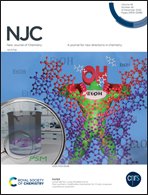Construction of hydrophilic covalent organic frameworks and their fast and efficient adsorption of cationic dyes from aqueous solution†
Abstract
Research on functionalized covalent organic framework (COF) materials with good hydrophilic characteristics is significant on account of their application in the removal of dyes in wastewater. In this work, two anionic COF materials (TFPB-Pa-SO3H COF and TFPB-BDSA COF) were successfully synthesized with sulfonated modification as dyestuff sorbents to be used for the adsorption of cationic dyes. The two prepared COF materials exhibited predominant hydrophilicity with lower water contact angles (35° and 27°) than reported COF materials. The sulfonated groups on the COFs can efficiently adsorb cationic dyes via electrostatic interaction, which can moderately ameliorate their adsorptive capacity toward hydrosoluble dyes. TFPB-Pa-SO3H COF and TFPB-BDSA COF showed superfast adsorption equilibrium with methylene blue (1 and 2 min) and high adsorption uptakes of crystal violet (1559 and 1288 mg g−1), which manifested that the adsorption rate may be closely related to the solubilities of the host COF materials as well as the guest dye molecule in aqueous solution. Meanwhile, the adsorption stability between the COF materials and dye molecule adsorbed on the COF skeleton accounted for the highly effective adsorption of the target dye in a large quantity. In addition, TFPB-Pa-SO3H COF as an adsorbing material was successfully applied for the removal of dye molecules in real water samples.



 Please wait while we load your content...
Please wait while we load your content...